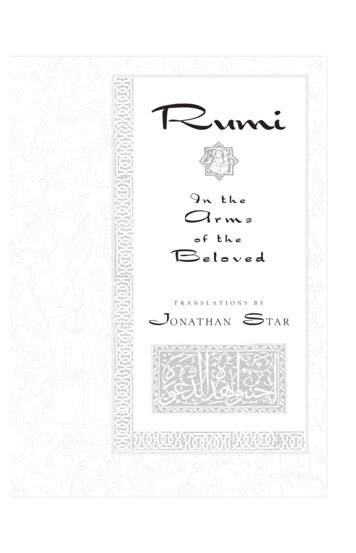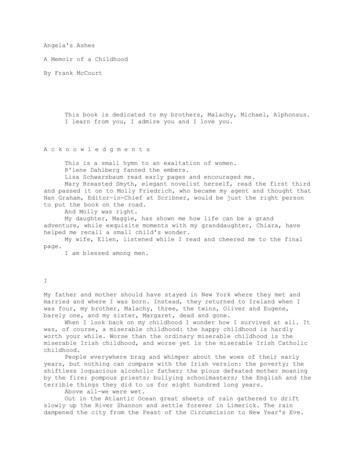
Transcription
Fire, Flames and Ashes. How Tibetan Poets Talk aboutSelf-Immolations without Talking about ThemFrançoise Robin(INALCO, ASIEs)Since its inception in 2005, Tibetan websites from within Tibetand, later, blogs, became a working tool with which to evaluate how the fraction of young Tibetans endowed with cultural capital represent social and ethnic crisis and react to it. This instance of “infrapolitics of the powerless”1 became especially obviousin 2008, when a large-scale revolt started spreading in Lhasa and theTibetan plateau for the first time in 20 years: poetry published onlinefor days on revealed the lay Tibetan elite discourse about these dramatic events unfolding on the Tibetan plateau. But the identity ofarrested protesters, or even the place where protests were takingplace, were not dealt with by these bloggers. Those who did pass onimages or information paid a high price, ranging from 5 to 15 yearsjail sentence,2 suspected of “disclosing state secrets.” If factual information was not possible, what did these bloggers talk about instead?They resorted to metaphors to express their angst: tempests and hurricanes were raging, strong winds, gales, black and red storms wereblowing on the plateau, lakes and rivers froze under harsh climaticconditions, darkness enveloped the earth, wolves were howling,threatening harmless and defenseless sheep. As was obvious to all,those parallels with the mineral and animal kingdoms symbolizedthe gloom, despair, and helplessness felt by bloggers as armed forcesswarmed on the Tibetan plateau. Resorting to similes was nothingnew for Tibetans: thanks to their long-established and rich literature,Tibetan writers and poetry lovers were fully equipped to producesuch works, and readers deciphered them easily. Centuries ago, Ti-12James Scott, Domination and the Arts of Resistance. Hidden Transcripts. New Haven& London: Yale University Press, 1990, xiii.A state employee, Rikdzin Wangmo, received a 5-year jail sentence, the famoussinger Jamyangkyi was arrested and interrogated for one month and partly owedher release to international collective action. Upon her liberation, not fearingreprisals, she published the account of her days in jail. This was later translatedinto English and published under the title A Sequence of Tortures: A Diary ofInterrogations (Dharamsala: Tibetan Women Association, n.d.). Konchok Tsepel,administrator of a popular literature website, was sentenced to 15 years in jail.Françoise Robin, “Fire, flames and ashes. How Tibetan poets talk about self-immilations without talking about them”, Revue d’Etudes Tibétaines, no. 25, Décembre 2012, pp. 123-131.
124Revue d’Etudes Tibétainesbetan literati had classified ngonjo rikpa, which can be translated as‘lexicology’ or ‘science of similes,’ as one of the 5 ‘lesser sciences’ thatan accomplished cleric was supposed to master: virtuosity in the artof metaphors, similes and parallels, was deemed significant enoughto be part of the scholarly curriculum. Apart from being a tool testifying intellectual distinction, it enabled writers to cleverly hide theircriticisms and sarcasms towards spiritual or worldly opponents, evenin pre-1950s Tibet. Today’s poets, among whom one finds not onlyclerics, but a high proportion of high school students and universitygraduates, have perpetuated this tradition, but opacity and doubleentendre have now become basic tools for political survival in thepublic arena. On the vibrant blogosphere, Tibetan writers have become “experts at metaphors,” to use an expression applied to JaanKross, the most influential Estonian writer of the 20th century.3This imperative of self-preservation explains why the Tibetanblogosphere in China seems on the surface to have remained silenton the topic of self-immolation. Quests for “auto-cremation” 4 onsearch engines in Tibetan, whatever the expression may be originally,5 yield little results. But fire, torch, embers, cinders, flames, butterlamps, dust, have made a forceful appearance in Tibetan poems sinceOctober 2011.The first poem that alluded to immolations, as far as I can tell,came only with the wave of October 2011 immolations which alsoattracted the world’s attention: the first was “Mourning” (Tib. Myangan zhu ba) by the famous and charismatic Sangdor (b. 1976?),6 onOctober 10. Two days later “Flames are flying” (Mye lce ’phur gyin’dug) by Durphak7 was posted online; “Lost lives” (Bor song ba’i tshesrog) by Dremila appeared on October 15–it had apparently beenwritten on the October 12.8 A fourth poem, entitled “Fire has burntagain” (Yang me sgron song) by Domepa,9 appeared on that same day.This coincided with 3 immolations: one on October 3 and two on Oc-3456789Jacob Antoine, « Jaan Kross, L’art de dénoncer les absurdités de l’Histoire parl’écriture », Le Courrier des pays de l'Est, 1066(2), 2008, pp. 89-91.This term is used by J. Benn, Burning for the Buddha: Self-immolation in ChineseBuddhism. Honolulu: University of Hawaii Press, 2007. It encapsulates twoelements which the word ‘immolation’ does not include: the fact that immolatorsact upon themselves, and that they use fire to perpetuate their act.See Katia Buffetrille’s and Chung Tsering’s contributions in this issue for a list ofterms.http://www.sangdhor.com/blog c.asp?id 4907&a sangdhor. Sangdor is theonly poet whose year of birth can be specified in this article, as I have noinformation regarding the others.http://www.sangdhor.com/blog c.asp?id 4951&a maliysia.http://www.sangdhor.com/blog c.asp?id 4983&a 1988021.http://www.sangdhor.com/blog c.asp?id 5049&a 09758533066.
Fire, flames and ashes125tober 7. One last poem in this ‘October series’ was posted by someonecalled Tsetan Dorje, apparently a young monk from the Drigungschool of Tibetan Buddhism. It is entitled “Don’t say auto-cremationis violence” (Rang lus mer bsregs ’tshe ba ma gsungs shig). This poemwas censored and is still irretrievable. The first 4 poems were postedon the same website, Sangdhor, which is run by the poet Sangdor,10who had launched himself the movement with his own poem,“Mourning.” Unsurprisingly, this website was closed not long afterthe publication of these 4 poems, possibly because Sangdor’s ownpoem was translated into English and attracted the censors’ attention,or because the posting of 4 poems, obviously mourning the selfimmolators’ death, might have been considered too much for thecensors.One had to wait until the auto-cremation of a reincarnated lama,Lama Sobha, on 8 January 2012, to see the second wave of poems: itbegan with “Flames propagate from my homeland, Darlak” (Pha yuldar lag nas me lce mched thal) by Yepeng (?),11 a rather active youngerblogger. The poem bore as a subtitle “An incident that happened at 5in the morning of January 8 2012,”12 which leaves little doubt as to theevent referred to. He published another poem 7 days later entitled “Iwas able to shout a war cry at the burning ground” (Me ’bar sa nas ki’bod thub thal), but this poem was censored and it has not been restored yet, like the rest of the poetic production of this author. Whenlooking for it on the internet, the following formula appears: “Youwill be able to read this post only after the web administrator haschecked it” (zin tho ’di do dam pas zhib bsher byas rjes da gzod lta klogbyed thub). The day after the auto-cremation, the blogger Shokjangentered the stage. He is famous among Tibetan youth for having beendetained for several months in 2010 after writing openly criticalcomments of the 2008 Chinese state handling of events in Tibet. According to its title “Written for Lhamkog and his ‘A way a butterlamp burns’” (Lham kog gis mchod me sbar stangs shig la bris pa), thepoem seems to be a rejoinder to a poem by another active poet on theTibetan blogosphere, Lhamkok, although I could not find it. Shokjang’s poem is subtitled “On the way butter lamps burn” (Mchod mesbar tshul).13The fact that the person who had immolated in early January wasa trulku (reincarnated lama) may partly explain why it resonated sostrongly with Tibetan bloggers, but another reason might be the rela-10111213When mentioning him as a person, I do not follow the spelling chosen bySangdor for his website s/47198.aspx.2012 1 5 zhogs pa’i dus tshod lnga steng byung ba’i don rkyen cig.http://www.sangdhor.com/blog c.asp?id 5728&a 3.
126Revue d’Etudes Tibétainestive geographical proximity of the location of this immolation withmany bloggers: Lama Sobha was from Golok, an area pertaining tothe Qinghai province, where many bloggers came from, so theymight have been able to connect more easily with him than with other self-immolators, who hailed from different regions. Some mighthave even known him, which was unlikely to be the case of younger,ordinary monks or ex-monks from faraway Ngawa or Kardze.The third series of poems was posted online between February 10and 20 2012. It coincided with another wave of auto-cremations inFebruary (8, 9, 11, 13, 17 and 19). One poem by someone called Jampel Dorje was entitled “Offering to the demise of a stranger” (Rgyusmed kyi mi zhig gi ’chi ’pho la phul ba) and obviously referred to a selfimmolator, though it is hard to identify precisely who.14 The simultaneous advent of Tibetan New Year was the occasion of a number ofpoems, two of which referred obliquely to self-immolations: “A versified poem for 2012” (2012 lo’i tshigs bcad cig) by Droktruk15 and “Celebrate New Year like this” (Lo gsar ’di ltar gtong) by a blogger callinghimself Gongdeba. 16 Although devoid of clear hints to selfimmolations, the poem ends with a call to celebrate New Year bylighting a butter lamp in remembrance of the “heroes,” for the clearlight of ultimate truth, and for aspirations to hope.17 This reference toheroes, to ultimate truth and hope can be interpreted as allusions tothe self-immolators of the past Tibetan year.Between March and June 2012, in spite of 3 new self-immolationshaving been recorded, hardly any poem referring to them was postedfrom within Tibet. The crystal clear “Master, the end of my shawl isburning” (Ston pa/Nga’i gzan sne me ru ’bar song) on March 15 followed the much-commented self-immolation of Jamyang Palden, atRongwo monastery, in March 14. But its author, Lunyon, is an activemonk blogger in exile. The poem was censored within 24 hours of itsposting online in Tibet.18 But surprisingly the website altogether wasnot closed down, although this was a tense period for Tibetans. Twomore poems may be ascribable to the self-immolations: “Tibet” (Bod)by Lungbu,19 on March 30 and “Butter lamp, the pillar of my t ist 25/201202204152.html. This poet has a blog:http:// blog.amdo com/space.php?uid 496&do blog&id 1080. The name isnot given in Tibetan, only in Roman letters.dpa’ bo yi rjes dran la mchod me spar / bden mtha yi ’od gsal la mchod me spar / re ba yismon ’dun la mchod me spar / mchod me yi ’od ngogs su lo gsar gtong/http://blog.nbyzwhzx. com/space.php?uid 496&do blog&id 1080.http://www.sangdhor.com/blog c.asp?id 5962&a 203301730.html.
Fire, flames and ashes127(Mchod me/Nga’i sems kyi rdo ring), by Dhi Kalsang on April 3.20 Butthey are so allusive, at least to my understanding, that linking themwith immolations could be an over interpretation.Let’s now turn to the poems themselves. I will first look into howthey manage to create powerful imagery, and then how they refer tothe tragic events that triggered them.Anthropomorphisation of fire is a literary strategy adopted byseveral authors. In this instance, it is not a mere rhetoric and literarydevice, as at some point during the cremation process, the body isfire and fire is the body. In Sangdor’s “Mourning,” the fire’s mouth ismoving (’gul), the fire’s hands are drilling (gsor), the fire’s chest isshowing itself (ston). Fire, that is, the self-immolator, then turns into arosary of fire whose beads fall one by one onto the ground. It thenturns into smoke (du ba), also anthropomorphised, which gazes intothe monastery’s roof and every monk’s cell.In the poem “Flames are flying,” fire and flames are also animatedwith life: flames are described as biting humble humans and turbulent dogs, possibly an allusion to Tibetans and Chinese respectively,and smoke is described as licking them.Another literary tactic consists in establishing parallels with objects and shapes without ever naming the basis of the parallel. Thetitle of Shokjang’s poem (“The way a butter lamp burns”) subscribesto the often found simile between the body in flame and the butterlamp, but includes other powerful and eloquent similarities: an armor of copper (to defend Tibet?), then a sharp hammer (to strike enemies?), and finally a big bronze bell (to summon Tibetans?). Thepoem ends with the narrator hearing: “Wake up from your slumber!”a call coming from what has not been and will not be named, butwhich is obviously the burning body of the self-cremating person.The poem “Fire is raging again” also relies on strong visual imagery, this time describing crudely the body in flame in its last moment:the flesh and bones, quivering in pain, are struggling to make theirvery last steps before collapsing. The poem ends with the descriptionof smoke, settling down on the ground, while the last atom of flameis absorbed in the space between the ground and the sky. These lastatoms of the charred body are also the focus of another poem: in thefinal scene of “Offering to the demise of a stranger,” “people nearby”are described as gathering atoms or specks of dust in the coat of itsowner, obviously the person who has just self-immolated. Images ofcharred bodies carefully wrapped in coats immediately come to20http://www.sangdhor.com/blog c.asp?id 6142&a 1988021.
128Revue d’Etudes Tibétainesmind, underscoring the respect, care and attention that the selfimmolator received from people surrounding him, for his heroic act.Another poem chooses other senses than the visual: it mentionssounds like the cracking of a match, with “a sharper sound than thatof monastery bells in the wind.” Obviously this refers to the crackingof bones burning. It also refers crudely to the scorching smell (gzhobdri) of a charred body and describes it as dissolving at a crossroads.Shokjang’s poem also frames it within a given location: “The bluesmoke that swirls from the ashes of your bones, left behind as leftovers, this blue smoke is like a rope tied up between mountains.” Contrary to other poems, it gives agency to the self-immolator: “You didnot fly a kite, you did not throw stones You flew your own dusteverywhere, as if competing with eagles.”Hints to the background or to the motives of the self-immolatorscan be found in some poems: Sangdor’s “Mourning” poem beginswith “Because living felt more hopeless than dying” and it ends withthe classical “storm and wind” metaphor, which usually refers toChinese troops and here can be interpreted as the armed forcesswarming on the place as soon as the immolations occurred, as weknow happened in most if not all cases. In “Fire is raging again,” theimage of someone handcuffed and trapped in a cobweb is obviouslya reference to Tibetans “caught” helplessly in China polity. The poem“Flames spread in my hometown Darlak,” apart from its clear subtitle that reads almost like a newspaper heading (“An accident thatoccurred at 5AM”), also mentions the way in which the lama committed auto-cremation, although by way of allusion more than directly:“In this quiet environment / A mani chanter woke up / He left afterhaving tasted / A mouthful of something close to alcohol.”21 This isin obvious reference to the attested fact that the lama drank kerosenebefore setting himself on fire, as a way to ensure that he would diefor sure.Other poems, on the whole, are silent about the motives: is it because they are so obvious to readers that they need no explanation, orbecause too many details would jeopardise their publishing? “Lostlives” by Dremila stands out: rather than resorting to vivid imageryand ”fugitive impressions through an artistic medium that best conserves their emotional impact”,22 it asks whether one or two fires (lit.“heaps of fire,” me dpung) will be able to make “Tibetans break thewrecked chair they are sitting on” (rotten China?), “enable them touse their thin pen” (exerting right to self-expression?), or “make use2122lhang ’jags kyi khor yug nas / ma ni bzlo mkhan cig sad te / a rag lta bu’i bzzi kha can ciggi / ro myong nas bud song zig /.Sarah Kendzior, “Poetry of witness: Uzbek identity and the response to Andijon,”Central Asian Survey, 26(3), September 2007, p. 331.
Fire, flames and ashes129of their worn out name card” (restoring Tibetan eroded identity?). Itasks whether the bonfires will enable Tibetans “to be the masters oftheir crooked dogs’ legs” (walk on their feet?), to give up their wornout voice (to dare to shout?), to make them give their violent behavior (stop feuding?), and ends with the question: will we be able tostrive for perfect action? This is the only poem I have read that questions the benefit of self-immolations: “will these bonfires be able tomake up for the leaders that we have lost and the history books thatremain?”ConclusionTibetan society today is still highly literary, but is also highly censored, as there is no forum for public discussion of contentious topics, especially those related to ethnicity and the eroding Tibetan cultural identity. The one way out of this “dialectic of disguise and surveillance”23 is a clever use of literature, the one kind of authorizedpublic activity. Published texts do contradict the official state narrative and, in our case, far from condemning self-immolators as “terrorists,” “outcasts,” “criminals,” and “mentally ill people,” they speak ofthem with respect and empathy.But one can question doubly the efficiency of this “use of literature:” first, it addresses only Tibetans as almost no Han Chinese canread Tibetan. In this case, it is tantamount to “preaching to the choir.”The use of literature resides more here in collective mourning, mutual solace and a reinforcement of an injured Tibetan identity. Secondly, given the necessary self-censorship that Tibetans deploy, thesevenues cannot act as a medium to develop an “independent exchange of ideas—the very thing that most threatens a state dependent on suppression and censorship.”24 We are a thus long distancefrom a fully articulated blogosphere where Tibetan netizens woulddirectly vie with state officials and state narrative. Still, one maycome occasionally across glimpses of discussion and debates: thepoem “Don’t say auto-cremation is violence” mentioned above seemsto take position in favour of auto-cremation and to defend it as compatible with the non-violent approach put forward by the Dalai-Lamain the Tibetan struggle for freedom. An online Tibetan encyclopediafrom Qinghai shows a question asked on November 11 2011 bysomeone called Gyaltan: he would like website users to share theirfeelings and opinions about the self-cremation of a Tibetan on No-2324James Scott, op. cit. p. 4.Sarah Kendzior, “Poetry of witness,” op. cit., p. 332.
130Revue d’Etudes Tibétainesvember 11 in Swayambunath (Nepal). It only elicited one reply thattentatively suggests that this person did it “for the sake of religion.”25Incidentally, no self-immolation was reported as having taken placein Nepal in November. More significantly, one social commentatorargued, two days after the first immolation in March 2011, that “taking one’s own life is proof of a great courage.”26 The website onwhich it was published has been a regular target of censorship andhas been closed down for two months. In April 2012 came a secondcommentary to self-immolations: someone wrote a short piece called“Stopping courage” (Spobs pa ’gog byed)27 asking what kind of courageit was to abandon one’s own life, which is as precious as gold, ratherthan facing “spite, bullying, belittling, jail and beating” which affectshundreds of thousands of beings. This is an obvious reference towhat the writer perceives as the doomed fate of Tibetans currentlyliving under China. Last, Naktsang Nulo, a retired lawyer fromAmdo famous for publishing his uncompromising and unauthorisedautobiography in 2005, mentioned the self-immolations twice in anopenly sad online lament about the current and overall Tibetan situation, “A sadness that will never clear up.”28 He links these desperateacts to other instances of protest like street demonstrations, and statesclearly that these numerous immolations “are done with the higherobjective of [benefitting] one’s nationality” and indicate “hope [ofbeing heard] and protest towards the authorities in power.”But these web pages are the exception rather than the rule. So far,writers, bloggers and intellectuals, who are the “socially concerned”29fringe of the Tibetan society endowed with cultural capital, have hadto restrict their use of internet and poetry online as a mere “release[of pent-up] resentment.”30 But, contrary to “scar literature” whichwas officially allowed in the late 1970s in China as a catharsis toevacuate the trauma of the Cultural Revolution in the present case,the trauma keeps deepening without much hope for an end to html.http://www.rdrol.net/node/252 The topic of courage (snying stobs) and strength(stobs) is gaining currency on the Tibetan blogosphere.www.tibetcm.com/html/list ture/prose/2012-05-27/384.html.Perry Links, The Uses of Literature: Life in the Socialist Chinese Literary System.Princeton: Princeton University Press, 2000, p. 314.Link, Uses of Literature, op. cit., p. 319.
Fire, flames and ashes131GLOSSARYTranscriptionDhi KalsangTransliterationDhi Skal bzangTibetanDomepaMdo med paམ ་ ད་པ།Dremila’Dre mi laའ ་ ་ལ།Drigung’Bri gungའ ་ ང་།Droktruk’Brog phrugའ ག་ གDurphakDur ’phag ར་འཕགGolokMgo logམ ་ གGyaltanRgyal bstan ལ་བ ན།Jampel Dorje’Jam dpal rdo rje’Jam dbyangs dpalldan’Jam dbyangs skyidའཇམ་དཔལ་ ་ །དཀར་མ ས།Lama SobhaDkar mdzesDkon mchog tshe’phelBla ma Bsod bhaLungbuRlung bu ང་ །LunyonKlu smyon ་ ན།Naktsang NuloNags tshang nus bloནགས་ཚང་ ས་ །NgawaRnga ba ་བ།ngonjo rikpamngon brjod rig paམ ན་བ ད་ ག་པ།Rikdzin WangmoRig ’dzin dbang mo ག་འ ན་དབང་ །RongwoRong bo ང་ །SangdorSeng rdor ང་ ར།ShokjangZhogs ljang གས་ ང་།trulkusprul sku ལ་ །Tsetan DorjeTshe brtan rdo rje ་བ ན་ ་ །Jamyang PaldanJamyangkyiKardzeKonchok Tsepelv ་ ལ་བཟང་།འཇམ་ད ངས་དཔལ་ ན།འཇམ་ད ངས་ ད།ད ན་མ ག་ ་འ ལ། ་མ་བ ད་བྷ།
lighting a butter lamp in remembrance of the “heroes,” for the clear light of ultimate truth, and for aspirations to hope.17 This reference to heroes, to ultimate truth and hope can be interpreted as allusions to the self-immolators of the past Tibetan year. Betwee










